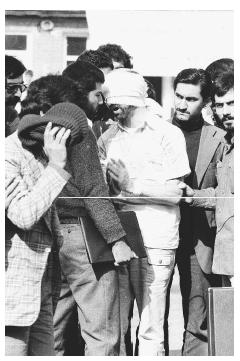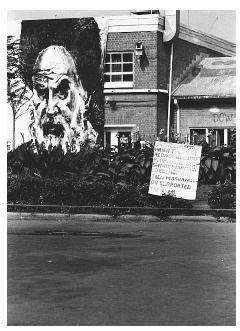Iranian Hostage Crisis
█ STEPHANIE WATSON
On November 4, 1979, a group of Iranian militants stormed the American embassy in Tehran, Iran, and captured dozens of embassy and military personnel. For 444 days, fiftytwo Americans remained captive in Iran, while their nation waited, hoped, and hung yellow ribbons. The outcome of the hostage crisis would ultimately change the course of a presidency, and malign relations between two powerful nations.
The origins of anti-American fervor. In the early 1970s, America and Iran enjoyed mutually satisfying relations. At the time, the country was ruled by Shah Mohammad Reza Pahlavi, a man the American government had supported for more than twenty-five years. Pahlavi had risen to power thanks to British and Soviet forces, which jointly installed Pahlavi on the throne in 1941 to gain valuable influence over the country's oil. Two years later, the United States and Great Britain made a formal declaration to promote Iran's independence, primarily to prevent the communists from gaining a strong foothold in the country.
In the early 1950s, the Iranian prime minister, Mohammad Mossadegh, began gaining power and public support, and vehemently opposed the western influence in Iran. In 1952, Mossadegh's party won the national elections, and he demanded control over Iran's armed forces, which Pahlavi denied. In 1953, the United States Central

Intelligence Agency (CIA) secretly helped to overthrow Mossadegh and restore Pahlavi to power. Pahlavi remained a friend to the United States, but endured harsh criticism by his countrymen for ruling with an iron fist, and living opulently off the spoils of his country's oil production while the majority of his people lived in poverty. During the next two decades, the Shah attempted to bring further Western influence to Iran, a practice that was an anathema to the growing numbers of fundamentalist Islamic groups in the country. Those who dared oppose the Shah's rule faced the risk of torture or death at the hands of his secret police.
In 1978, Iranian opposition leaders organized strikes, demonstrations, and riots in protest of the Shah's policies. In Paris, exiled Islamic leader Ayatolla Ruhollah Khomeini (Pahlavi had sent Khomeini from the country amid riots in the early 1960s) slowly began to gain popularity among the Iranian people. In December, 1978, Khomeini issued a proclamation calling for Iranians to "unite, arise, and sacrifice your blood," urging them to defy the Shah's order prohibiting public demonstrations. Khomeini's words

inspired his followers to fill the streets, chanting religious slogans and calling for revolution. The Shah was left with two choices: surrender or clamp down on his people militarily to restore order. On January 16, 1979, the Shah stepped down from power and fled to Morocco.
Khomeini returned to Iran on February 1, 1979, where he was greeted by millions of his followers. Less than two weeks later, Khomeini assumed power, announcing the creation of a new fundamentalist Islamic state. Khomeini labeled the United States "The Great Satan." Hatred grew when U.S. President Jimmy Carter allowed the deposed Shah to travel to America later that year for cancer treatment. Furious students gathered in the streets, raising their fists and shouting, "Death to America," assuming the United States was again trying to secretly restore the Shah to power.
On the morning of November 4, 1979, Iranian fervor reached a boiling point. A crowd gathered around the U.S. embassy, shouting anti-American slogans. At 10:30 A.M. about three thousand people jumped the ten-foot wall surrounding the embassy and swarmed the grounds, forcing their way into the basement and first floor of the chancery building. The guards launched tear gas, but they were unable to control the mob. The Islamic militants rounded up 66 embassy workers, military officials, and Marine guards. The hostages were blindfolded, bound, and shoved into windowless rooms. Fifty-three people were held captive in the embassy compound. It was unclear what role, if any, Khomeini played in orchestrating the hostage crisis, but it was clear that he did little to stop it. When Khomeini noted how popular the hostage situation had become among his people, he allowed it to continue, despite continuous pressure from the United States government.
Americans watched the events of the crisis played out on television. Yellow ribbons were tied around tree trunks throughout the country in commemoration of the hostages. President Carter responded by freezing billions of dollars in Iranian assets, both in the United States and abroad, and by instituting an embargo on Iranian oil. Still, the Iranians refused to release the hostages, demanding the Shah's extradition to Iran.
A rescue attempt. While President Carter was trying to negotiate the hostages' release, behind-the-scenes a daring rescue plan was taking shape. The proposal was to swoop in and land eight American military helicopters in the embassy compound, extract the hostages, and escape to six planes waiting on an airstrip in the Iranian desert. On April 24, 1980, the plan was launched. The mission, however, was fraught with mistakes and bad luck. Three of the helicopters malfunctioned; the pilot of a fourth, blinded by a dust storm, crashed into a refueling aircraft. Eight U.S. servicemen were killed in the unsuccessful operation.
The hostage-takers responded to the failed rescue attempt by moving their captives to several secret locations in different cities. On July 11, one ill captive was released. Meanwhile, the ongoing hostage crisis was costing President Carter the support of his people and some of his advisors, including Secretary of State Cyrus Vance, who had opposed the rescue. Carter later lost his reelection bid to former California governor Ronald Reagan in a landslide.
The siege ends. In the fall of 1980, the exiled Shah died of cancer complications. In September, Iran agreed to begin negotiations for the hostages' release. In exchange for their release, the United States agreed to turn over $8 billion of Iran's frozen assets, and to refrain from interfering politically or militarily in Iran's internal affairs. The United States and Iran signed the agreement on January 19, 1981, but in a final embarrassment to Carter, the militants did not release the hostages until January 20, the day President Reagan was inaugurated. Just minutes after Reagan took office, a plane carrying the fifty-two remaining hostages left Tehran for a U.S. Army base in Germany. From his home in Georgia, former president Carter announced that the plane carrying the hostages had cleared Iranian airspace, and that every one of the hostages "was alive, was well, and free."
█ FURTHER READING:
BOOKS:
Rivers, Gayle, and James Hudson. The Teheran Contract. Garden City, New York: Doubleday & Company, Inc.,1981.
Sick, Gary. All Fall Down: America's Tragic Encounter with Iran. New York: Random House, Inc., 1985.
Wells, Tim. Four Hundred and Forty-Four Days: The Hostages Remember. Orlando, Florida: Harcourt Brace Jovanovich Publishers, 1985.
PERIODICALS:
Schaumburg, Ron. "Americans Held Hostage." New York Times Upfront. (January 15, 2001):23.
Olson, Tod. "America Held Hostage: The Iranian Hostage Crisis Would Torment America—and Topple a President." Scholastic Update. (May 11, 1998):20–22.
SEE ALSO
Carter Adminstration (1977–1981), United States National
Security Policy
Iran, Intelligence and Security
Comment about this article, ask questions, or add new information about this topic: